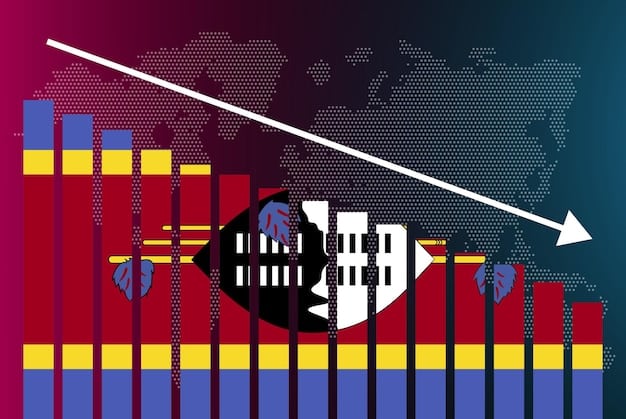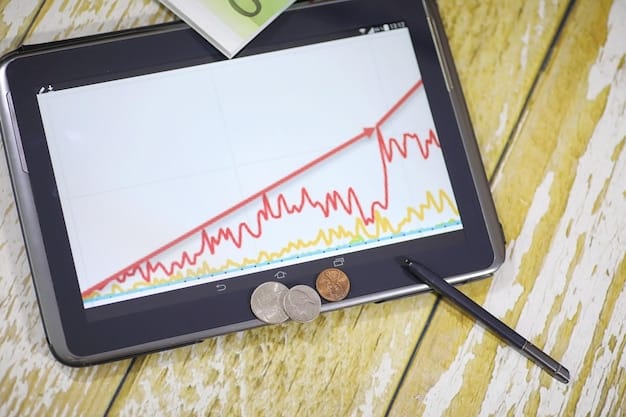Navigate Economic Downturns: A 5-Step Guide to Timeless Reports

Timeless reports offer a strategic advantage in navigating economic downturns by providing historical context, identifying patterns, and informing proactive decision-making, thereby mitigating risks and capitalizing on emerging opportunities.
Economic uncertainty can be daunting, but with the right tools, you can navigate even the toughest times. Timeless reports are invaluable resources that offer insights and strategies to protect your assets and make informed decisions during an economic downturn.
Understanding the Power of Timeless Reports
Timeless reports provide a historical perspective on economic cycles, allowing you to identify recurring patterns and trends. This understanding is crucial for making informed decisions and avoiding common pitfalls during economic downturns. These reports offer insights that transcend current market conditions, giving you a long-term view of potential risks and opportunities.
What Makes a Report “Timeless”?
A timeless report isn’t just any document filled with data. It possesses qualities that make it relevant and insightful across different time periods. It focuses on fundamental economic principles, long-term historical data, and proven investment strategies.
Why Historical Data Matters
Analyzing historical economic data is crucial for understanding the potential impact of current events. By examining past downturns, you can gain insights into how markets typically behave, which sectors are most vulnerable, and what strategies have been successful in mitigating losses.
- 📊 Provides context for current economic conditions.
- 🕰️ Helps identify recurring patterns and trends.
- 🛡️ Informs strategies to protect assets during downturns.
In conclusion, timeless reports serve as guiding lights, illuminating the path to informed decision-making during economic rough patches. They’re not just documents; they’re strategic tools that can give you a significant edge.
Step 1: Identifying Key Economic Indicators
To effectively utilize timeless reports, you must first identify the key economic indicators that provide the most relevant insights. These indicators serve as barometers of economic health, offering early warnings of potential downturns and insights into recovery trends. Focusing on these indicators allows you to stay informed and make timely adjustments to your financial strategy.
Leading Indicators
Leading indicators are economic variables that tend to change before the economy as a whole changes. These indicators can provide early signals of an upcoming downturn, enabling you to prepare in advance.
Lagging Indicators
Lagging indicators, on the other hand, change after the economy has already begun to follow a particular pattern or trend. While they might not help in predicting the start of a downturn, they confirm trends and can guide decisions related to recovery strategies.

- 📈 GDP Growth: A measure of the economy’s overall performance.
- 💼 Unemployment Rate: Indicates the percentage of the labor force that is jobless.
- 💸 Inflation Rate: Reflects the rate at which the general level of prices for goods and services is rising.
Identifying and tracking key economic indicators is the foundation for using timeless reports effectively. These indicators, combined with historical data, provide a comprehensive view of economic conditions, enabling you to make informed decisions.
Step 2: Accessing Reliable Timeless Reports
Accessing reliable timeless reports is crucial for informed decision-making. Not all reports are created equal, and the quality of information can vary greatly. Identifying credible sources and understanding the methodologies used in these reports is essential for ensuring the insights you gain are accurate and trustworthy. This step ensures that you’re basing your strategies on solid, verifiable data.
Government Publications
Government agencies often produce comprehensive economic reports that are publicly available. These publications provide a wealth of data and analysis on various aspects of the economy.
Academic Research
Academic institutions and research organizations conduct studies that can offer valuable insights into long-term economic trends. These reports are often peer-reviewed, adding a layer of credibility to the findings.
- 🏛️ Ensure the source is reputable and unbiased.
- 🔬 Look for peer-reviewed studies and publications.
- 📊 Check for transparency in data collection and analysis methods.
Accessing reliable timeless reports ensures that your decisions are based on accurate and trustworthy information. By focusing on credible sources and understanding the methodologies used, you can gain a deeper understanding of economic trends and potential risks.
Step 3: Analyzing Trends and Patterns
Analyzing trends and patterns within timeless reports is where the real value lies. This step involves sifting through data to identify significant trends, recurring patterns, and potential turning points in the economy. The ability to interpret these patterns can provide a strategic advantage in navigating economic downturns.
Identifying Recurring Cycles
Economic cycles, such as booms and busts, are a recurring feature of market economies. Timeless reports can help you identify these cycles and understand their characteristics.
Comparative Analysis
Comparing current economic conditions with past downturns can provide valuable insights into potential outcomes. This involves examining key indicators and understanding how they relate to historical events.

Analyzing trends and patterns in timeless reports requires a keen eye and a thorough understanding of economic principles. By identifying recurring cycles and conducting comparative analysis, you can develop a more nuanced understanding of economic dynamics.
Step 4: Formulating Proactive Strategies
Formulating proactive strategies based on the analysis of timeless reports is where you translate insights into actionable plans. This step involves identifying potential risks and opportunities and developing strategies to mitigate the risks and capitalize on the opportunities. Proactive strategies are crucial for protecting assets and positioning yourself for long-term financial success.
Risk Mitigation Strategies
Based on the trends identified in timeless reports, develop strategies to mitigate potential risks. This may involve diversifying your investment portfolio, reducing debt, or increasing cash reserves.
Opportunity Capitalization Strategies
Economic downturns can also present opportunities to acquire assets at discounted prices or invest in emerging industries. Identify these opportunities and develop strategies to capitalize on them.
- 🛡️ Diversify investments to reduce risk exposure.
- 💰 Increase cash reserves for strategic acquisitions.
- 🌱 Invest in resilient sectors and emerging opportunities.
Formulating proactive strategies requires a forward-thinking approach and a willingness to adapt to changing economic conditions. By developing strategies to mitigate risks and capitalize on opportunities, you can navigate economic downturns with confidence.
Step 5: Monitoring and Adapting
Monitoring and adapting your strategies is an ongoing process. Economic conditions are constantly evolving, and your strategies must be flexible enough to adapt to these changes. Regularly reviewing timeless reports and adjusting your plans accordingly is essential for long-term success. This ensures that you stay ahead of the curve and continue to make informed decisions.
Regular Review of Economic Indicators
Continuously monitor key economic indicators to assess the effectiveness of your strategies. This involves tracking changes in GDP growth, unemployment rate, inflation, and other relevant metrics.
Adapting to Changing Conditions
Be prepared to adjust your strategies as economic conditions change. This may involve rebalancing your investment portfolio, modifying your risk tolerance, or exploring new opportunities.
Monitoring and adapting your strategies is a critical component of navigating economic downturns successfully. By staying informed and remaining flexible, you can protect your assets and position yourself for long-term financial success.
| Key Point | Brief Description |
|---|---|
| 📚 Historical Data | Understand past downturns to predict future trends. |
| 🔎 Economic Indicators | Identify key factors signaling economic shifts. |
| 🛡️ Risk Mitigation | Strategies to protect assets during downturns. |
| 🌱 Growth Opportunities | Identify potential for new investments. |
FAQ
▼
Timeless reports are economic documents providing lasting insights into historical patterns and trends. They help in understanding market dynamics beyond immediate conditions.
▼
These reports offer a stable reference point, helping you avoid emotional decisions. They enable informed choices based on well-established historical data.
▼
Good sources include government publications, academic institutions, and reputable financial research firms. Always verify the credibility of the source.
▼
Focus on key economic indicators, identifying recurring cycles, and comparing current conditions with past events. Look for trends that suggest future possibilities.
▼
No, they are not a guaranteed solution but rather a guide. Economic predictions are never foolproof, so it’s important to combine the insights from these reports.
Conclusion
By understanding the power of timeless reports and implementing these five steps, you can gain a strategic advantage in navigating economic downturns. These reports offer invaluable insights, enabling you to make informed decisions, mitigate risks, and capitalize on emerging opportunities. Remember to stay informed, adapt to changing conditions, and consult with financial professionals to ensure your strategies align with your specific circumstances.





